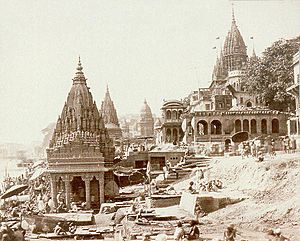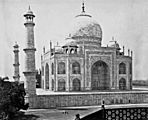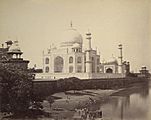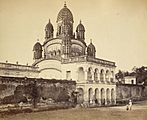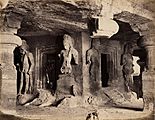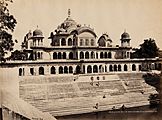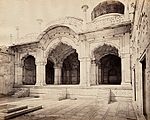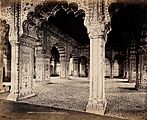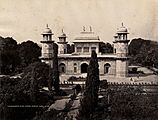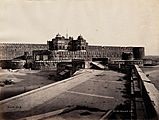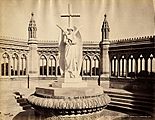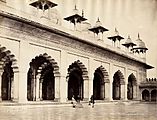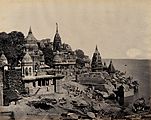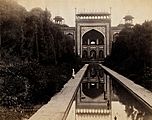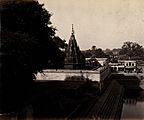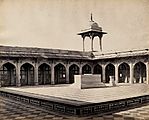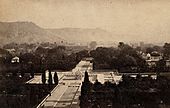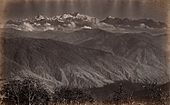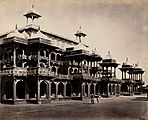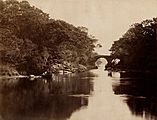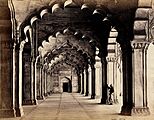Samuel Bourne facts for kids
Quick facts for kids
Samuel Bourne
|
|
|---|---|
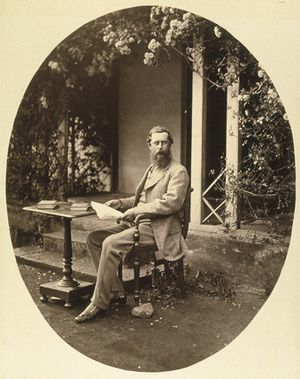 |
|
| Born | 30 October 1834 Staffordshire, England
|
| Died | 24 April 1912 |
| Occupation | Photographer |
| Style | Landscapes, Ethnographic Portraits |
Samuel Bourne (born October 30, 1834 – died April 24, 1912) was a British photographer. He is famous for the seven years he spent working in India, from 1863 to 1870. During this time, he took many amazing pictures.
He started a photography business called Bourne & Shepherd with Charles Shepherd. They first opened in Shimla in 1863. Later, they opened another studio in Kolkata (which was called Calcutta back then). This company was very old and finally closed in June 2016.
Contents
Early Life and Photography Journey
Samuel Bourne was born on October 30, 1834, in a place called Napley Heath in England. It was near the border of Staffordshire and Shropshire. His parents were Thomas and Harriet Bourne.
After finishing school, he got a job at a bank in Nottingham in 1855. Around this time, he started photography as a hobby. He quickly became very good at taking pictures of landscapes. He even gave talks about photography and wrote articles for photography magazines.
In 1858, Bourne went on a photography trip to the Lake District. In 1859, he showed his photos at an exhibition in Nottingham. The next year, his pictures were shown in London at a big exhibition. Because his work was so well-received, he decided to leave his bank job. He then sailed to India in early 1863 to become a professional photographer.
Photography Work in India
When Samuel Bourne first arrived in Kolkata (Calcutta), he partnered with another photographer named William Howard. They moved to Simla and opened a new studio called 'Howard & Bourne'. In 1864, Charles Shepherd joined them, and the business became 'Howard, Bourne & Shepherd'.
By 1866, after Howard left, it was known simply as 'Bourne & Shepherd'. This studio became the most important photography business in India. It was possibly the oldest photography business in the world until it closed in 2016. Charles Shepherd usually stayed in Simla. He managed the studio, printed photos, and sold Bourne's landscape pictures. Meanwhile, Bourne traveled all over India.
Bourne worked for six very busy years in India. By the time he went back to England in January 1871, he had taken about 2,200 beautiful pictures. These photos showed the amazing landscapes and buildings of India and the Himalayas. He mostly used a large camera and a difficult method called the Wet Plate Collodion process. This process was complicated and took a lot of effort. Even so, his photos were always excellent quality and often very artistic. He was able to take amazing pictures even in the most remote parts of the Himalayas. This makes him one of the best travel photographers of the 1800s.
Himalayan Expeditions
On July 29, 1863, Bourne began his first of three big photography trips to the Himalayas. He had about 30 porters to carry all his equipment. He traveled across the Simla Hills to Chini, near the Sutlej River. He spent time photographing this area before returning to Simla in October 1863. He came back with 147 great photo negatives.
The next year, Bourne started another long trip, which lasted nine months, to Kashmir. He left Lahore in March and traveled through many towns like Kangra and Dharmsala. He reached Kashmir in June and spent weeks photographing its beautiful scenery. He then went to Srinagar, where he stayed for a while. His journey back included places like Baramula, Delhi, and Kanpur (Cawnpore). He arrived in Lucknow on Christmas Eve 1864.
Bourne's third and last major trip was his most challenging. It was a six-month journey into the Himalayas. His goal was to find and photograph the source of the Ganges River. He left Simla on July 3, 1866. He traveled with Dr. G.R. Playfair through Kulu and Lahaul. They crossed the Kunzum Pass into the Spiti valley, where they later went their separate ways.
Bourne continued alone with his forty porters. He climbed over the Manirung Pass, which is 18,600 feet high. He took spectacular photos there. These were the highest altitude photographs ever taken for twenty years! Then he went down to where the Spiti and Sutlej Rivers meet. He continued to the Upper Ganges Valley and then to the Gangotri Glacier. There, he photographed one of the main sources of the Ganges. It flows out from an ice cave at Gaumukh. His return trip included Agra, Mussoorie, and Naini Tal. He arrived back in Simla just in time for Christmas! Bourne wrote a lot about his travels in the Himalayas. His letters were published in The British Journal of Photography between 1863 and 1870.
The photography business grew well. In 1866, they opened a second studio in Kolkata (Calcutta). They ran a portrait studio there, and their photos were sold all over India. They were also sold in Britain by distributors. In 1867, he briefly went back to England to marry Mary Tolley. They both returned to India later that year. He continued to travel and took about 500 more great pictures. He left India for good in November 1870. Another photographer named Colin Murray took over Bourne's role. Murray continued to take beautiful pictures of India in a similar style. He later managed the business.
After returning to England, Samuel Bourne sold his share in the Bourne & Shepherd studios. He stopped working as a commercial photographer. However, his collection of about 2,200 glass plate negatives stayed with the studio. These photos were printed and sold for over 140 years. Sadly, they were all destroyed in a fire in Kolkata on February 6, 1991.
Life Back in England
Samuel Bourne settled back in Nottingham, England. He started a new business that made cotton thread, working with his brother-in-law. This business did well, and Bourne became a local judge.
Even though he continued to take photos as a hobby and joined a local photography club, he spent most of his creative energy on watercolor painting. He died in Nottingham on April 24, 1912.
Samuel Bourne is rightly seen as one of the best landscape and travel photographers of the 1800s in India. He was great at arranging his photos and had excellent technical skills.
Where You Can See His Work
Samuel Bourne's photographs are kept in the permanent collections of many museums. Some of these include:
- the Princeton University Art Museum
- the Harvard Art Museums
- the National Gallery of Art, Washington, DC
- the Detroit Institute of Arts
- the Clark Art Institute
- the Museum of New Zealand Te Papa Tongarewa
- the Museum of Modern Art
- the Brooklyn Museum
- the Victoria and Albert Museum
- the Metropolitan Museum of Art
- the University of Michigan Museum of Art
- the Museum of Fine Arts, Houston
- the National Galleries of Scotland
- the San Francisco Museum of Modern Art
Gallery
See also
- John Burke (photographer)
- Frederick Fiebig
- Linnaeus Tripe


